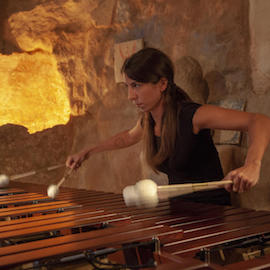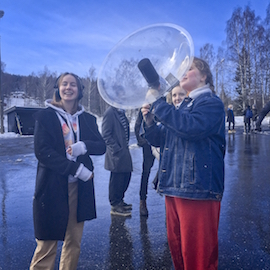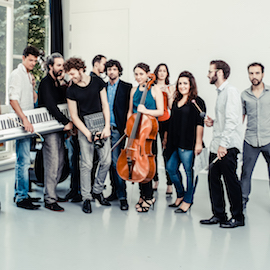ULYSSES Audience Research Blog #1 – impuls, Graz (AT)
02/2017 impuls – AT
Welcome to the first ULYSSES Network research blog post!
I’ll be reporting here on the progress of the Audience Research branch of the ULYSSES Network, as well as presenting some of my thoughts and impressions as I travel to each of the 13 partner institutions in the ULYSSES Network over the next two years. Our audience survey of new music events across Europe got underway in February with the first research stop in Graz, Austria, home of the impuls festival and academy for contemporary music. Founded by Beat Furrer and Ernst Kovacic in 1998, impuls transforms Graz into a lively centre of musical production for two weeks each February. Alongside workshops and seminars for young composers, there is a wide variety of concerts and other events open to the general public.
The Audience Research questionnaire was handed out at two events at impuls, a concert by Ensemble Schallfeld on 17.02.17, and an all-day event the following day with short concerts in a number of art galleries across the city. This provided ample opportunity to test out the procedure and questionnaire and to gauge audience members’ interest in the survey. At the first event, we placed 370 questionnaires on the auditorium seats before the concert. The audience, around 320 people in total, showed a lot of interest in them and the response was fantastic – 141 completed questionnaires! A first look at the data suggests that, as expected, the audience at the Ensemble Schallfeld concert was predominantly an expert one, comprised largely of composers and performers of contemporary music who were attending the Impuls academy. Despite their ‘insider’ status in the realm of new music and their professional connection to the festival, most of these survey participants did still view themselves as audience members, offering comments about the pieces and sometimes mentioning unsatisfactory aspects of their concert-going experience. Indeed, several responses mentioned having wanted more information about the music and performers. Feedback such as this goes to show how deciding what to tell audiences about the music (and what not) is an important consideration for organisers, especially in the field of contemporary art where even expert audiences can feel like they’re in the dark.
The gallery concerts the following day brought out a different side to impuls’ audience. Over the course of this marathon-style event, we travelled around the city taking in a total of 11 half-hour concerts. I handed out questionnaires at various locations and received forty completed returns; once again, an impressive result. A number of responses commented on the event format, with several respondents asking for more concerts in this style. Despite the greater proportion of visitors from the wider public with little to no musical training (roughly 50%), I was reminded again by some comments that new music can be challenging for all, regardless of experience; one response from a contemporary music professional noted that ‘short concerts are the best format for new music, not only for the non-musician public!’. The day’s open format, which often left audience members free to wander around the exhibitions during performances, made for an informal yet concentrated atmosphere in which to experience both contemporary music and visual art.
All in all, a promising start in Graz. My encounters with audience members over the survey days were interesting and inspiring, with many finding it enjoyable to participate. This affirms my view that audience research is not just helpful for institutions, it also gives audiences themselves a chance to reflect on the artworks they have just experienced, encouraging a deeper interaction than might otherwise occur.
Top Music Picks: impuls 2017
- – The sublime performance of Pierluigi Billone’s Sgorgo Oo by the work’s dedicatee, electric guitarist Yaron Deutsch. Billone’s piece spills forth over the listener, only later revealing larger structures and patterns of repetition that gradually become perceptible. Sprawling, frenetic passages were atmospherically punctuated by heavy silences and rumbling low slides, all realised with a suspenseful, dramatic edge by Deutsch.
- – The gallery day made for a number of musical highlights, firstly, the premiere of Sonobe by Alyssa Aska, performed by bass koto player, Miyama McQueen-Tokita. The instrument simply has a captivating timbre, enhancing the work’s mesmerising textural shifts. The koto’s clarity and precision also resonated well with the minimal aesthetic of the textile gallery, the location for the first concert of the day. The afternoon concert at the Museum of Perception was another high point. Four violists (Alina Petrova, Sophie Wahlmüller, Emma Lloyd and Talvi Nurgamaa) performed a selection of seven pieces from György Kurtág’s Signs, Games and Messages distributed at different points around the circular exhibition space, producing an appropriate back-and-forth setup for Kurtág’s witty miniatures.
- – From the closing concert: Rebecca Saunders’ Fury II for solo double bass and ensemble was performed by an excellent group of student performers, who skilfully brought out the extremes of articulation that Saunders demands. Dynamic, tense and engaging to watch.
Next research stop: Tallinn, Estonia @ EPCC
Thanks go to Ute, Agnes and Katarina for their organisational help in Graz!
Gina Emerson




